Flexural Creep Behaviour of Pultruded GFRP Composites Cross-Arm: A Comparative Study on the Effects of Stacking Sequence
Abstract
:1. Introduction
2. Material and Methodology
2.1. Cross Arm Fabrication
2.2. Fibre Volume Fraction
2.3. Static 4-Point Bending Tests
2.4. Flexural Creep Test
3. Results and Discussions
3.1. Static Four-Point Bending Test Results
3.2. Flexural Creep Results
4. Conclusions
Author Contributions
Funding
Institutional Review Board Statement
Informed Consent Statement
Data Availability Statement
Acknowledgments
Conflicts of Interest
References
- Amir, A.L.; Ishak, M.R.; Yidris, N.; Zuhri, M.Y.M.; Asyraf, M.R.M. Advances of composite cross arms with incorporation of material core structures: Manufacturability, recent progress and views. J. Mater. Res. Technol. 2021, 13, 1115–1131. [Google Scholar] [CrossRef]
- Bakar, M.S.A.; Mohamad, D.; Ishak, Z.A.M.; Yusof, Z.M.; Salwi, N. Durability control of moisture degradation in GFRP cross arm transmission line towers. AIP Conf. Proc. 2018, 2031, 020027. [Google Scholar] [CrossRef]
- Sharaf, H.K.; Ishak, M.R.; Sapuan, S.M.; Yidris, N. Conceptual design of the cross-arm for the application in the transmission towers by using TRIZ–morphological chart–ANP methods. J. Mater. Res. Technol. 2020, 9, 9182–9188. [Google Scholar] [CrossRef]
- Selvaraj, M.; Kulkarni, S.; Babu, R.R. Analysis and experimental testing of a built-up composite cross arm in a transmission line tower for mechanical performance. Compos. Struct. 2013, 96, 1–7. [Google Scholar] [CrossRef]
- Alipour, H.J.; Aminnejad, S.; Jazaeri, M. Decreasing the right of way of transmission lines by using towers with polymer insulation arms. In Proceedings of the International Conference on Power Engineering, Energy and Electrical Drives, POWERENG, Setubal, Portugal, 12–14 April 2007; pp. 571–576. [Google Scholar] [CrossRef]
- Aboudi, J.; Al Azzawi, W.; Alampalli, S.; Aniskevich, A.; Barbero, E.J.; Beyle, A.; Bhuiyan, F.H.; Epaarachchi, J.; Fertig, R.S.; Glaskova-Kuzmina, T.; et al. Creep and Fatigue in Polymer Matrix Composites, 2nd ed.; Elsevier: Amsterdam, The Netherlands, 2019. [Google Scholar] [CrossRef]
- Findley, W.N. 26-Year creep and recovery of poly(vinyl chloride) and polyethylene. Polym. Eng. Sci. 1987, 27, 582–585. [Google Scholar] [CrossRef]
- Sá, M.F.; Gomes, A.M.; Correia, J.R.; Silvestre, N. Creep behavior of pultruded GFRP elements—Part 2: Analytical study. Compos. Struct. 2011, 93, 2409–2418. [Google Scholar] [CrossRef]
- Jayaprakash, K.; Desai, Y.M.; Naik, N.K. Fatigue behavior of [0n/90n]s composite cantilever beam under tip impulse loading. Compos. Struct. 2013, 99, 255–263. [Google Scholar] [CrossRef]
- Ascione, L.; Berardi, V.P.; D’Aponte, A. Creep phenomena in FRP materials. Mech. Res. Commun. 2012, 43, 15–21. [Google Scholar] [CrossRef]
- Sá, M.F.; Gomes, A.M.; Correia, J.R.; Silvestre, N. Creep behavior of pultruded GFRP elements—Part 1: Literature review and experimental study. Compos. Struct. 2011, 93, 2450–2459. [Google Scholar] [CrossRef]
- Muliana, A.H.; Haj-Ali, R.M. Analysis for creep behavior and collapse of thick-section composite structures. Compos. Struct. 2006, 73, 331–341. [Google Scholar] [CrossRef]
- Johari, A.N.; Ishak, M.R.; Leman, Z.; Yusoff, M.Z.M.; Asyraf, M.R.M. Influence of CaCO3 in pultruded glass fiber/unsaturated polyester resin composite on flexural creep behavior using conventional and time-temperature superposition principle methods. Polimery 2020, 65, 792–800. [Google Scholar] [CrossRef]
- Mallick, P.K. Fibre-Reinforced Composites Materials, Manufacturing and Design; CRC Press: Boca Raton, FL, USA, 2007; Volume 20. [Google Scholar] [CrossRef]
- Sá, M.F.; Gomes, A.M.; Correia, J.R.; Silvestre, N. Flexural creep response of pultruded GFRP deck panels: Proposal for obtaining full-section viscoelastic moduli and creep coefficients. Compos. Part B Eng. 2016, 98, 213–224. [Google Scholar] [CrossRef]
- Li, X.; Liu, W.; Fang, H.; Huo, R.; Wu, P. Flexural creep behavior and life prediction of GFRP-balsa sandwich beams. Compos. Struct. 2019, 224, 111009. [Google Scholar] [CrossRef]
- Bottoni, M.; Mazzotti, C.; Savoia, M. Creep tests on GFRP pultruded specimens subjected to traction or shear. Compos. Struct. 2014, 108, 514–523. [Google Scholar] [CrossRef]
- US Department of Defense. Composite Materials Handbook Volume 1: Polymer Matrix Composites-Guidelines for Characterisation of Structural Materials. Compos. Mater. Handb. Ser. 2002, 1, 1–586. [Google Scholar]
- Patel, P.; Chokshi, S. A Review of Fabrication Methods and Stacking Sequence Arrangements of Fiber for Composite. Int. J. Curr. Eng. Sci. Res. 2018, 5, 13–20. [Google Scholar]
- Beloshenko, V.; Voznyak, Y.; Voznyak, A.; Savchenko, B. New approach to production of fiber reinforced polymer hybrid composites. Compos. Part B Eng. 2017, 112, 22–30. [Google Scholar] [CrossRef]
- Mohamad, D.; Syamsir, A.; Beddu, S.; Kamal NL, M.; Zainoodin, M.M.; Razali, M.F. Effect of Laminate Properties on the Failure of Cross Arm Structure under Multi-Axial Load. IOP Conf. Ser. Mater. Sci. Eng. 2019, 530, 12029. [Google Scholar] [CrossRef]
- Asyraf, M.R.M.; Ishak, M.R.; Sapuan, S.M.; Yidris, N.; Ilyas, R.A. Woods and composites cantilever beam: A comprehensive review of experimental and numerical creep methodologies. J. Mater. Res. Technol. 2020, 9, 6759–6776. [Google Scholar] [CrossRef]
- Lu, T.; Solis-Ramos, E.; Yi, Y.; Kumosa, M. UV degradation model for polymers and polymer matrix composites. Polym. Degrad. Stab. 2018, 154, 203–210. [Google Scholar] [CrossRef]
- Kobelev, V. Some basic solutions for nonlinear creep. Int. J. Solids. Struct. 2014, 51, 3372–3381. [Google Scholar] [CrossRef] [Green Version]
- Beddu, S.; Syamsir, A.; Ishak, Z.A.M.; Yusof, Z.M.; Hudi, N.S.; Nabihah, S. Creep behavior of glass fibre reinforced polymer structures in crossarms transmission line towers. AIP Conf. Proc. 2018, 2031, 020039. [Google Scholar] [CrossRef]
- Othman, A.; Abdullah, S.; Ariffin, A.K.; Mohamed, N.A.N. Investigating the quasi-static axial crushing behavior of polymeric foam-filled composite pultrusion square tubes. J. Mater. 2014, 63, 446–459. [Google Scholar] [CrossRef]
- Abu Bakar, M.S.; Salit, M.S.; Mohamad Yusoff, M.Z.; Zainudin, E.S.; Ya, H.H. The crashworthiness performance of stacking sequence on filament wound hybrid composite energy absorption tube subjected to quasi-static compression load. J. Mater. Res. Technol. 2020, 9, 654–666. [Google Scholar] [CrossRef]
- Mohamad, D.; Syamsir, A.; Sa’Don, S.N.; Zahari, N.M.; Seman, S.A.H.A.; Razali, M.F.; Ng, F.C.; Abas, A. Stacking Sequence Effects on Performance of Composite Laminate Structure Subjected to Multi-Axial Quasi-Static Loading. IOP Conf. Ser. Mater. Sci. Eng. 2019, 530, 012030. [Google Scholar] [CrossRef]
- Supian, A.B.M.; Sapuan, S.M.; Zuhri, M.Y.M.; Zainudin, E.S.; Ya, H.H.; Hisham, H.N. Effect of winding orientation on energy absorption and failure modes of filament wound kenaf/glass fibre reinforced epoxy hybrid composite tubes under intermediate-velocity impact (IVI) load. J. Mater. Res. Technol. 2021, 10, 1–14. [Google Scholar] [CrossRef]
- Guades, E.; Aravinthan, T. Residual properties of square FRP composite tubes subjected to repeated axial impact. Compos. Struct. 2013, 95, 354–365. [Google Scholar] [CrossRef]
- Hao, A.; Chen, Y.; Chen, J.Y. Creep and recovery behavior of kenaf/polypropylene nonwoven composites. J. Appl. Polym. Sci. 2014, 131, 8864–8874. [Google Scholar] [CrossRef]
- Choi, Y.; Yuan, R.L. Time-Dependent Deformation of Pultruded Fiber Reinforced Polymer Composite Columns. J. Compos. Constr. 2003, 7, 356–362. [Google Scholar] [CrossRef]
- Mottram, J.T. Short- and long-term structural properties of pultruded beam assemblies fabricated using adhesive bonding. Compos. Struct. 1993, 25, 387–395. [Google Scholar] [CrossRef]
- ASTM Standard D2584; Standard Test Method for Ignition Loss of Cured Reinforced Resin. ASTM: West Conshohocken, PA, USA, 2011; pp. 1–3. [CrossRef]
- Saba, N.; Paridah, M.T.; Jawaid, M. Mechanical properties of kenaf fibre reinforced polymer composite: A review. Constr. Build. Mater. 2015, 76, 87–96. [Google Scholar] [CrossRef]
- ASTM Standard D6272-17; Standard Test Method for Flexural Properties of Unreinforced and Reinforced Plastics and Electrical Insulating Materials by Four-Point Bending. ASTM: West Conshohocken, PA, USA, 2017; pp. 1–9. [CrossRef]
- Hibbeler, R. Structural Analysis, 9th ed.; Pearson: London, UK, 2015. [Google Scholar]
- ASTM Standard D2990-17; Standard Test Methods for Tensile, Compressive, and Flexural Creep and Creep- Rupture of Plastics. ASTM: West Conshohocken, PA, USA, 2017; pp. 1–21. [CrossRef]
- Asyraf, M.R.M.; Ishak, M.R.; Sapuan, S.M.; Yidris, N. Utilization of bracing arms as additional reinforcement in pultruded glass fiber-reinforced polymer composite cross-arms: Creep experimental and numerical analyses. Polymers 2021, 13, 620. [Google Scholar] [CrossRef] [PubMed]
- Shrivastava, R.; Singh, K.K.; Modi, V. Effect of Stacking Sequence on Interlaminar Shear Strength of Multidirectional GFRP Laminates. Mater. Today Proc. 2020, 22, 2207–2214. [Google Scholar] [CrossRef]
- Podolak, P.; Droździel, M.; Czapski, P.; Kubiak, T.; Bieniaś, J. The failure mode variation in post-buckled GFRP columns with different stacking sequences-Experimental damage analysis and numerical prediction. Int. J. Mech. Sci. 2021, 210, 106747. [Google Scholar] [CrossRef]
- Harries, K.A.; Guo, Q.; Cardoso, D. Creep and creep buckling of pultruded glass-reinforced polymer members. Compos. Struct. 2017, 181, 315–324. [Google Scholar] [CrossRef]
- Berardi, V.P.; Perrella, M.; Feo, L.; Cricrì, G. Creep behavior of GFRP laminates and their phases: Experimental investigation and analytical modeling. Compos. Part B Eng. 2017, 122, 136–144. [Google Scholar] [CrossRef]
- Scott, D.W.; Zureick, A.-H. Compression creep of a pultruded E-glass/vinylester composite. Compos. Sci. Technol. 1998, 58, 1361–1369. [Google Scholar] [CrossRef]
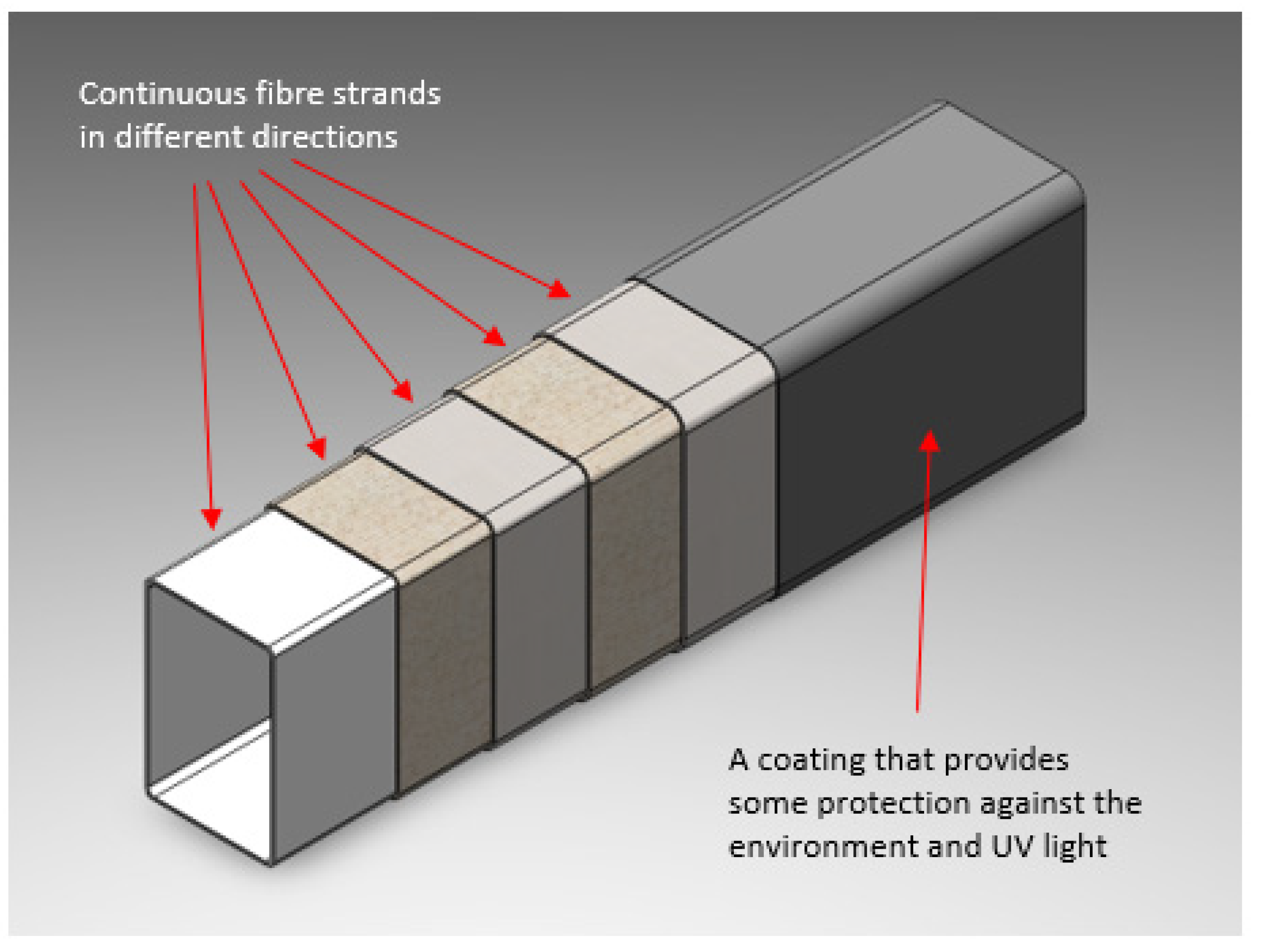
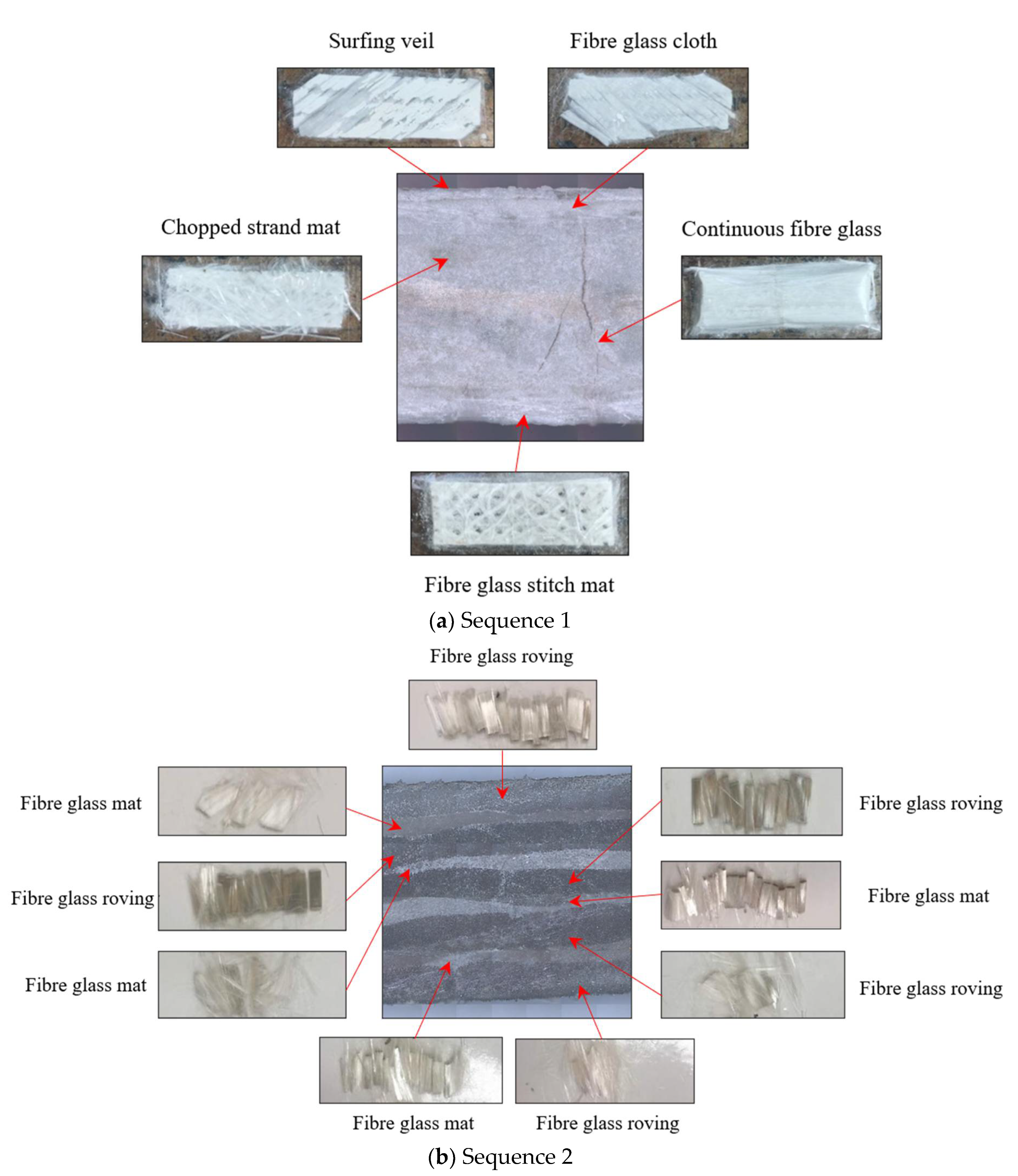

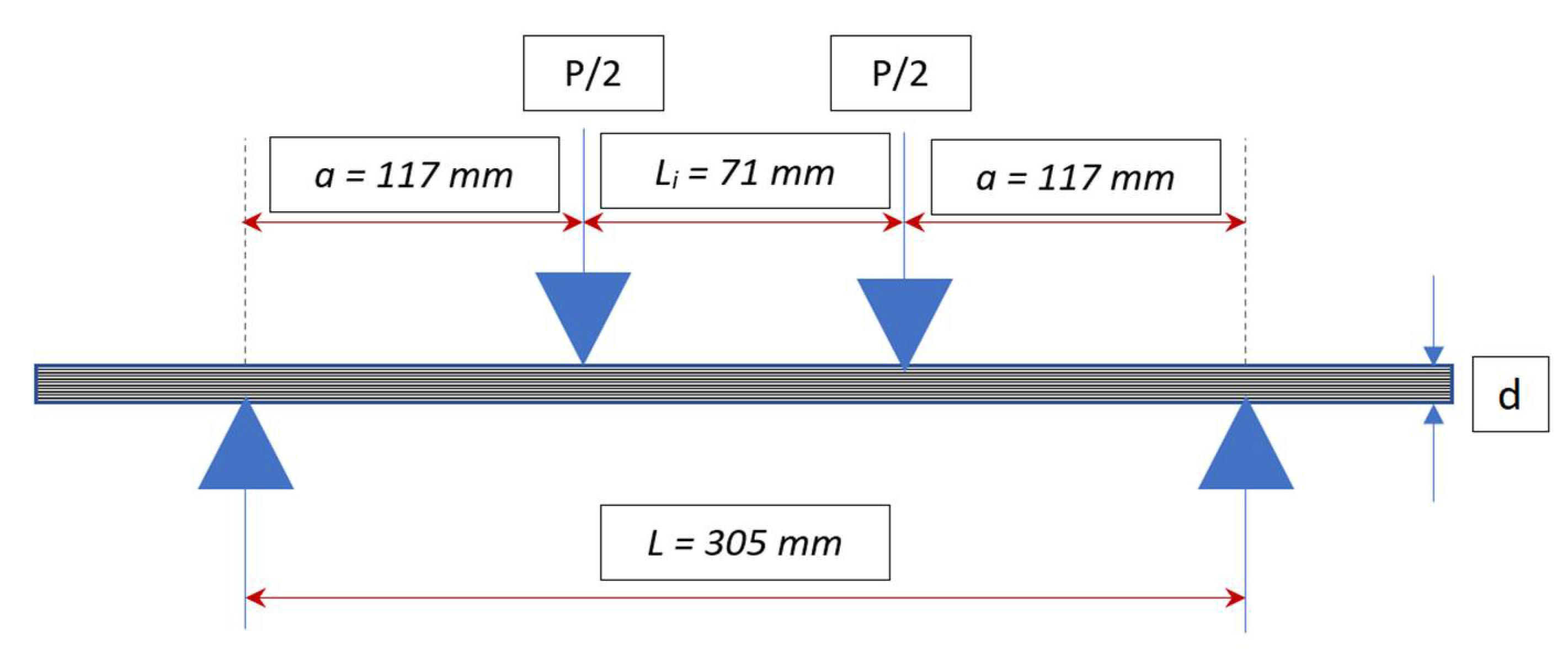
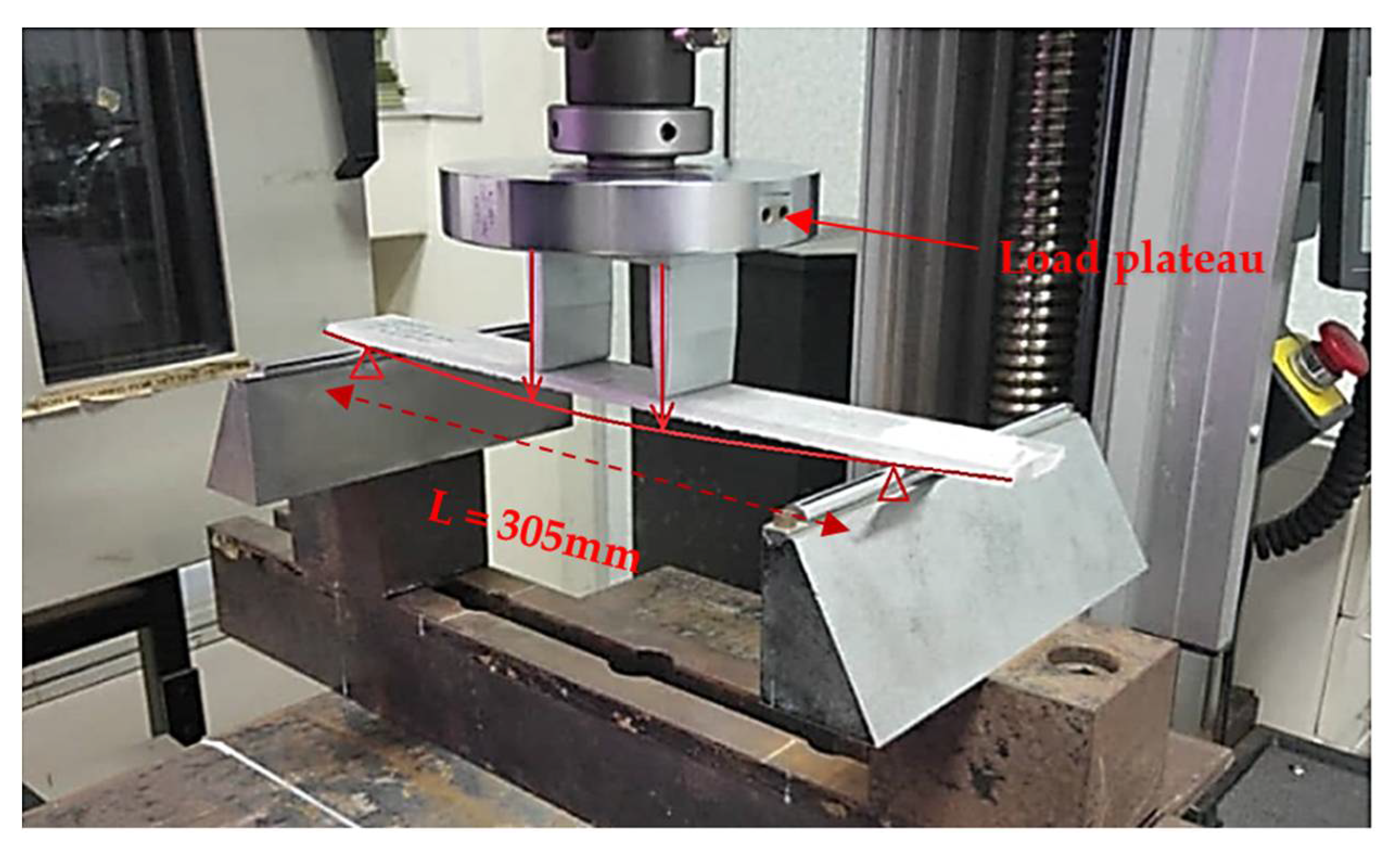
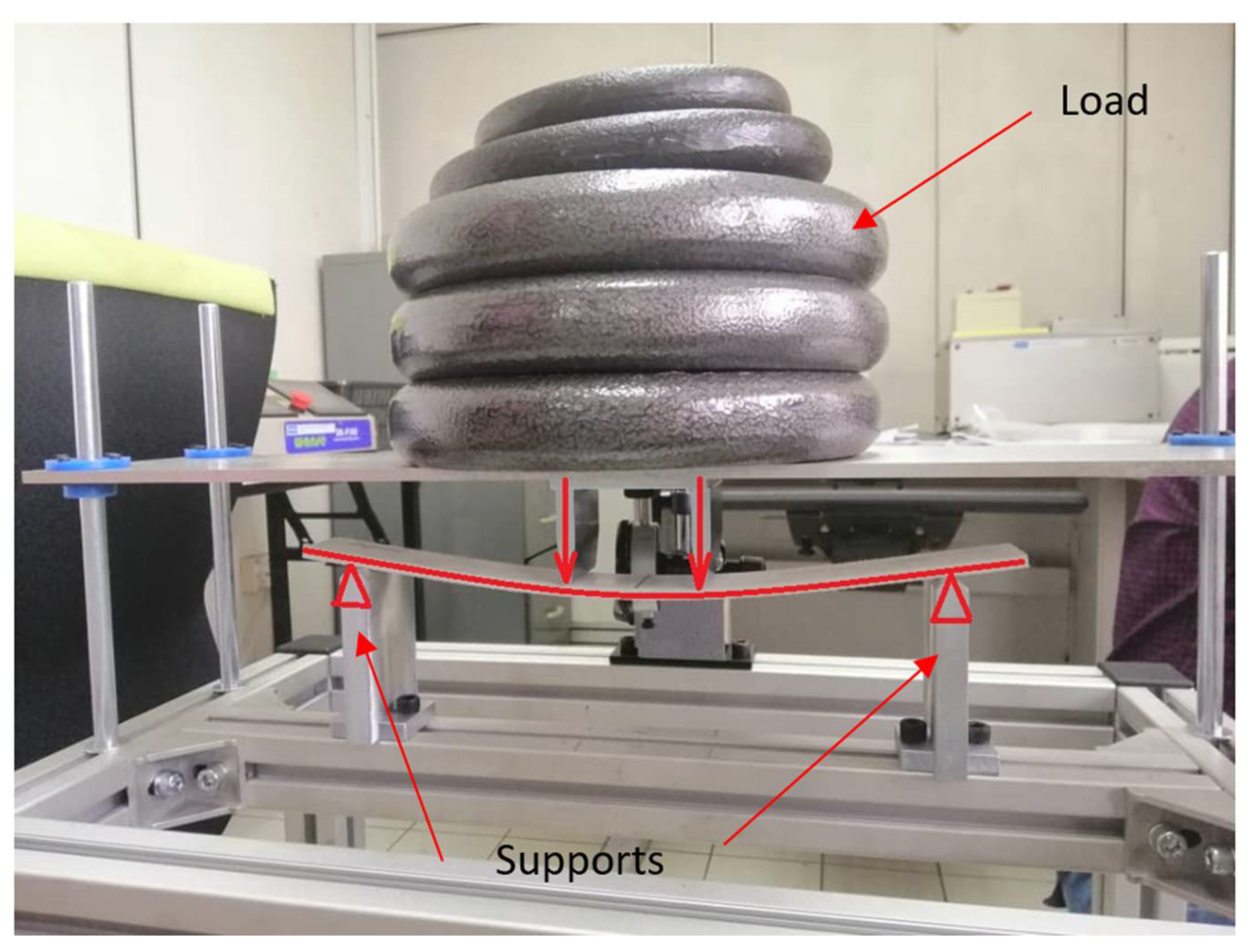
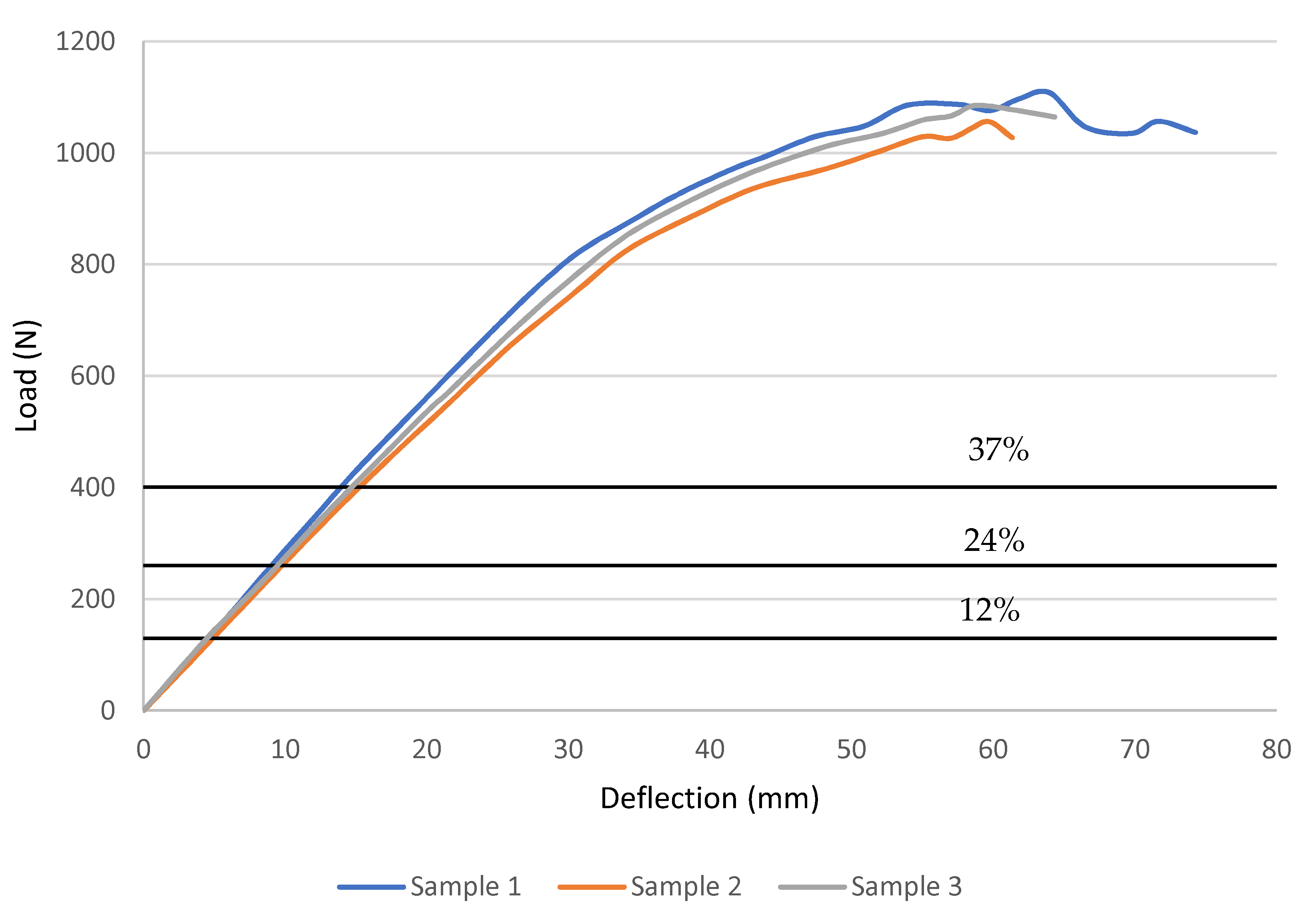



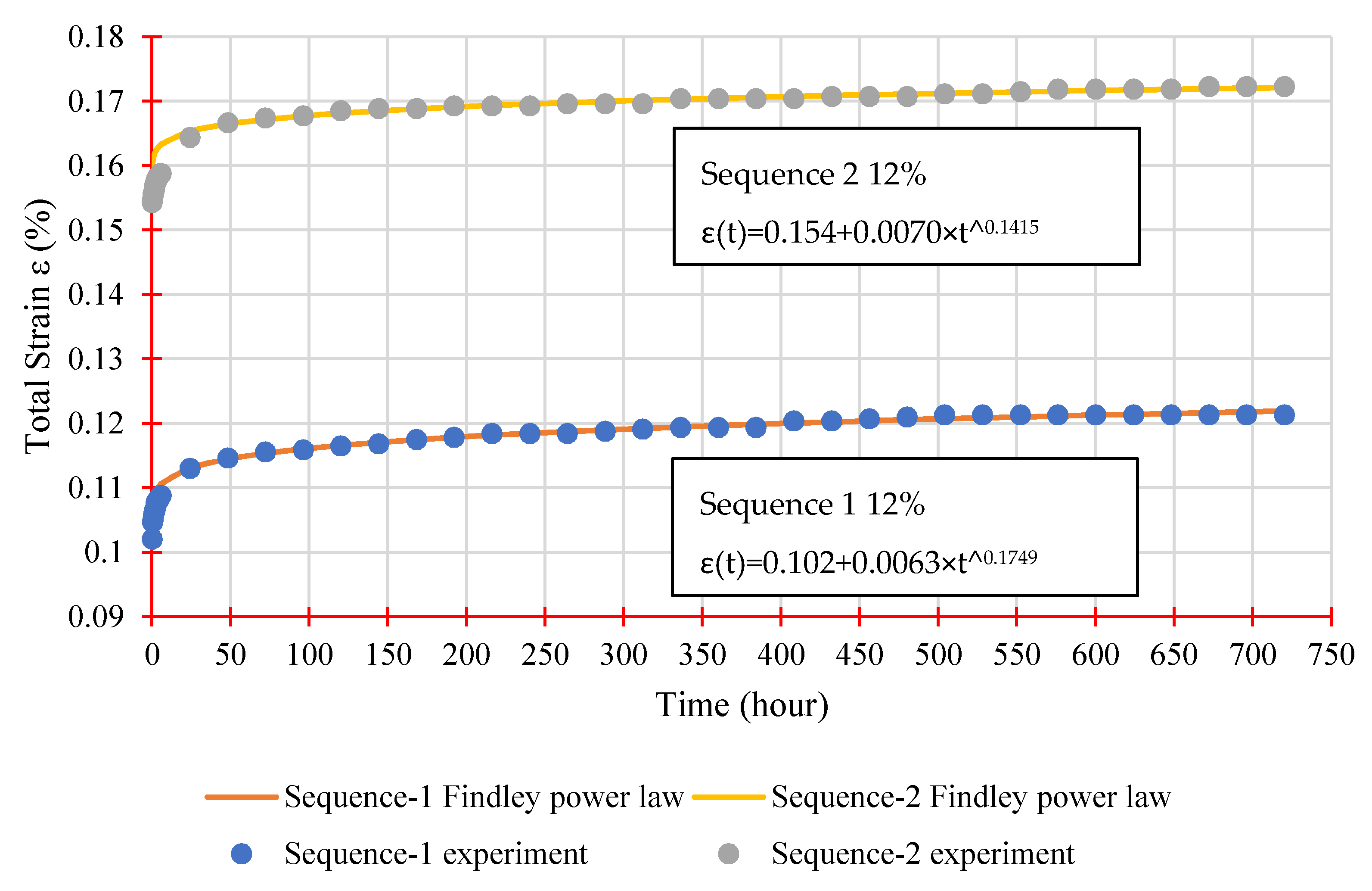
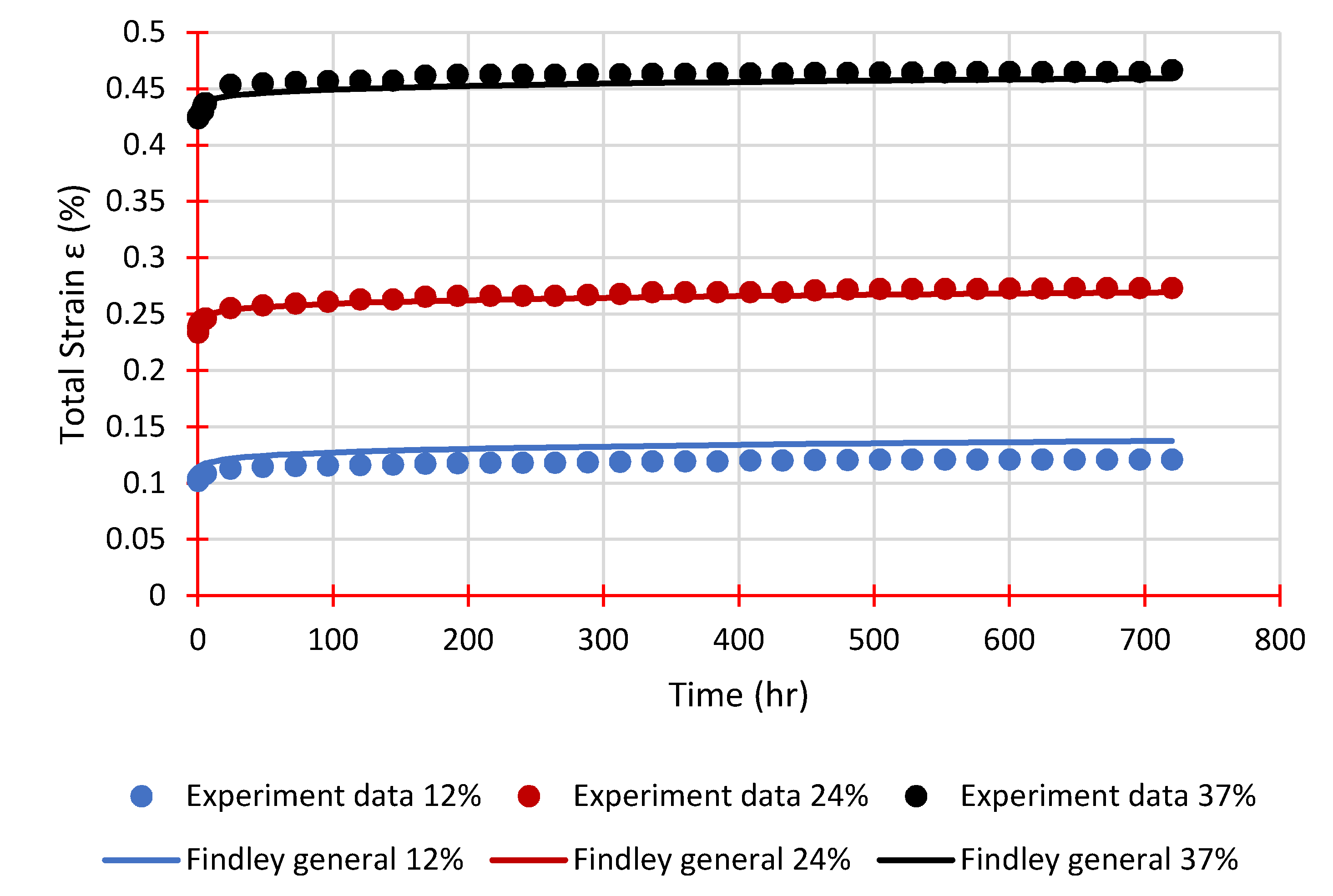

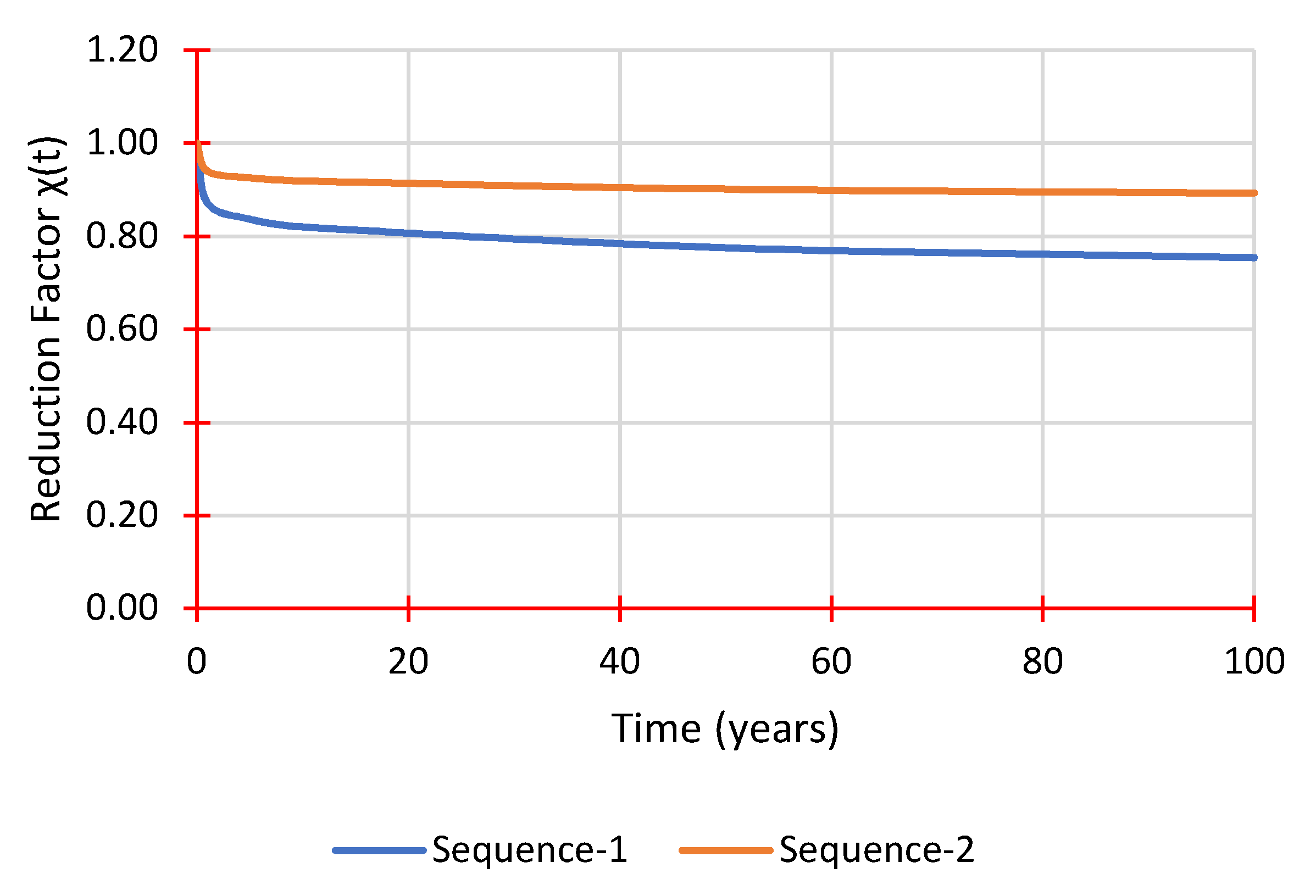
| Properties | Sequence 1 | Sequence 2 |
|---|---|---|
| Density (g/m3) | 1.80 | 2.01 |
| Young’s Modulus, (MPa) | 9530/4800 | 12,130/5100 |
| Shear Modulus, (MPa) | 4000 | 4280 |
| Compressive Strength, (MPa) | 150/65 | 320/76 |
| Tensile Strength, (MPa) | 321/80 | 429/100 |
| Fibre volume fraction, (%) | 61.95 | 70.45 |
| Sequence | Ultimate Strength (MPa) | Ultimate Strain (mm/mm) | Flexural Modulus (MPa) | |||
|---|---|---|---|---|---|---|
| Average | Average | E | Average | |||
| Sequence 1 | 248.3 | 242.6 | 0.02196 | 0.02289 | 18,706 | 17.879 |
| 236.7 | 0.02051 | 17,158 | ||||
| 242.9 | 0.02209 | 17,773 | ||||
| Sequence 2 | 407.9 | 399.05 | 0.02171 | 0.02197 | 23,003 | 21.880 |
| 391.9 | 0.02173 | 20,914 | ||||
| 397.3 | 0.02248 | 21,725 | ||||
| Sequence | Ultimate Flexural Load (N) | Load Level | Applied Load (N) |
|---|---|---|---|
| Sequence 1 | 1082 | 12% | 129.8 |
| 24% | 259.7 | ||
| 37% | 400.3 | ||
| Sequence 2 | 2192 | 12% | 263.0 |
| 24% | 526.1 | ||
| 37% | 811.0 |
| Sequence | Load Level | ||||
|---|---|---|---|---|---|
| Sequence 1 | 12% | 0.10207 | 0.00627 | 0.1749 | 531.0 |
| 24% | 0.23399 | 0.01230 | 0.1801 | 541.8 | |
| 37% | 0.42400 | 0.01554 | 0.1623 | 661.0 | |
| Sequence 2 | 12% | 0.15428 | 0.00702 | 0.1415 | 706.1 |
| 24% | 0.35350 | 0.00742 | 0.1324 | 1336.0 | |
| 37% | 0.64820 | 0.01071 | 0.1319 | 1427.3 |
| Time (Years) | Sequence 1 | Sequence 2 | ||
|---|---|---|---|---|
| χ(t) | E(t) (MPa) | χ(t) | E(t) (MPa) | |
| 1 | 0.87 | 15,619.1 | 0.94 | 20,624.1 |
| 5 | 0.84 | 15,000.3 | 0.93 | 20,323.7 |
| 10 | 0.82 | 14,695.2 | 0.92 | 20,176.0 |
| 50 | 0.77 | 13,893.2 | 0.90 | 19,785.4 |
Publisher’s Note: MDPI stays neutral with regard to jurisdictional claims in published maps and institutional affiliations. |
© 2022 by the authors. Licensee MDPI, Basel, Switzerland. This article is an open access article distributed under the terms and conditions of the Creative Commons Attribution (CC BY) license (https://creativecommons.org/licenses/by/4.0/).
Share and Cite
Alhayek, A.; Syamsir, A.; Supian, A.B.M.; Usman, F.; Asyraf, M.R.M.; Atiqah, M.A. Flexural Creep Behaviour of Pultruded GFRP Composites Cross-Arm: A Comparative Study on the Effects of Stacking Sequence. Polymers 2022, 14, 1330. https://doi.org/10.3390/polym14071330
Alhayek A, Syamsir A, Supian ABM, Usman F, Asyraf MRM, Atiqah MA. Flexural Creep Behaviour of Pultruded GFRP Composites Cross-Arm: A Comparative Study on the Effects of Stacking Sequence. Polymers. 2022; 14(7):1330. https://doi.org/10.3390/polym14071330
Chicago/Turabian StyleAlhayek, Abdulrahman, Agusril Syamsir, Abu Bakar Mohd Supian, Fathoni Usman, Muhammad Rizal Muhammad Asyraf, and Mohd Afdzaluddin Atiqah. 2022. "Flexural Creep Behaviour of Pultruded GFRP Composites Cross-Arm: A Comparative Study on the Effects of Stacking Sequence" Polymers 14, no. 7: 1330. https://doi.org/10.3390/polym14071330
APA StyleAlhayek, A., Syamsir, A., Supian, A. B. M., Usman, F., Asyraf, M. R. M., & Atiqah, M. A. (2022). Flexural Creep Behaviour of Pultruded GFRP Composites Cross-Arm: A Comparative Study on the Effects of Stacking Sequence. Polymers, 14(7), 1330. https://doi.org/10.3390/polym14071330











